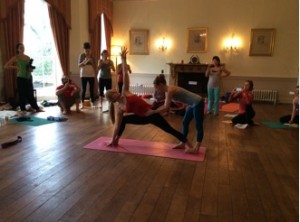 I have just finished my second Teacher Training Diploma (200 hour Yoga Alliance), specialising in Vinyasa Flow Yoga. I celebrate and live this beautiful experience everyday, as it truly was transformative, rich and inspiring. Our group of 22 beautiful yogis were guided by Claire Missingham, a wonderful teacher and human being, who instilled passion, knowledge and confidence into each of us. I feel wholly grateful for this enlightening and enlivening experience, which I intend to share with the community yogis around me.
I have just finished my second Teacher Training Diploma (200 hour Yoga Alliance), specialising in Vinyasa Flow Yoga. I celebrate and live this beautiful experience everyday, as it truly was transformative, rich and inspiring. Our group of 22 beautiful yogis were guided by Claire Missingham, a wonderful teacher and human being, who instilled passion, knowledge and confidence into each of us. I feel wholly grateful for this enlightening and enlivening experience, which I intend to share with the community yogis around me.
Vinyasa Flow Yoga is a creative, energising, flowing form of yoga, guided and led by the breath. Graceful movement rises with the inhale and falls with the exhale, creating fluid, flowing transitions between classical yoga postures.
It is a fusion of Ashtanga, Iyengar and Desikachar forms of yoga. Ashtanga is led by the breath, postures are held for a count of five and sequences are linked by Surya Namaskar vinyasa or sun salutations. Vinyasa Flow incorporates Surya Namaskar into each sequence and is led by the breath however, postures are held for 3,6,9,12 or 18 breaths.These breath counts are divisible by 108, a sacred Vedic number, revered across religions and cultures across the world (see www.swamij.com ). Ashtanga yoga is divided into three series: primary, secondary and tertiary.The sadhaka, or yogi, cannot progress to the next pose or series until they have mastered the stage they are working at. Ashtanga is a strict and disciplined practice, which requires a dedicated, focused, daily yoga sadhana. Vinyasa Flow is different each time and may only be mastered with dedication, love and daily sadhana, but allows more flexibility and freedom for the individual. The Vinyasa Flow yogi will feel they are progressing and going deeper, the more they practice: ‘The better you practice, the brighter the flame’ – BKS Iyengar.
Iyengar yoga was pioneered by Mr BKS Iyengar. This style of yoga is focused on the physical anatomy, alignment and use of props to access yoga asana correctly and safely, with optimal physical benefits. Iyengar incorporates all forms of pranayama, bandha and kriya, teaching that physical alignment leads to esoteric alignment and dhyana, meditation. His teachings are steeped in yogic tradition and ancient texts, primarily Patanjali’sYoga Sutras. His use of props is ultimately creative, however the sequences are not linked by transitions or led by the breath. Vinyasa Flow Yoga has a strong alignment focus within its flowing Namaskars and allows use of props and physical assist to encourage yogis to access poses with depth and anatomical alignment.
Krishnmacharya pioneered Vinyasa Flow Yoga during the early 20th century in India; his teachings spread across the country and worldwide. His work is continued by his son, Desikachar. They taught and used yoga as a therapeutic, healing practice, according to individual needs and abilities. Unique sequencing, guided by the inhalation and exhalation is termed Vinyasa Yoga. These sequences develop progressively, leading ultimately towards transformation and healing. Desikachar defines yoga as: attaining ‘what was previously unattainable’; change, movement or transformation within the body, our perception, ourselves. This progressive sequencing of postures is called Krama and is the methodology behind sequencing and choreography of contemporary Vinyasa Flow Yoga.
Krishnamacharya’s spiritual teachings, knowledge of Ayurveda, asana, pranayama, mudra, bandha, kriya, mantra and ancient texts allowed him inspire India and resurrect the yogic traditions of India, which had been slowly disappearing. Krishnamacharya taught BKS Iyengar, Desikachar and Patabi Jois. He is the grandfather of today’s Vinyasa Flow Yoga.
 Claire Missingham is dedicated and passionate about maintaining the Krishnamacharya lineage of Vinyasa Flow Yoga therefore, our course incorporated the historical background of Vinyasa Yoga, the ancient texts, Vinyasa kramic sequencing, asana, alignment, anatomy and physiology, esoteric anatomy, pranayama, bandha, kriya, marma points, aspects of Ayurvedic principles, practices and diet and yoga assists. It has been an incredible journey!
Claire Missingham is dedicated and passionate about maintaining the Krishnamacharya lineage of Vinyasa Flow Yoga therefore, our course incorporated the historical background of Vinyasa Yoga, the ancient texts, Vinyasa kramic sequencing, asana, alignment, anatomy and physiology, esoteric anatomy, pranayama, bandha, kriya, marma points, aspects of Ayurvedic principles, practices and diet and yoga assists. It has been an incredible journey!
As part of our course, we spent one week at a stately home in North Cadbury Court. This experience absorbed deeply into my being, studying in an Elizabethan-Georgian Manor, eating a vegetarian-Indian diet, practising and studying yoga from dawn until dusk, applying Ayurvedic cleansing and kriyatoour daily living.
Feeling so blessed to have had this experience and honoured to be working daily in the lineage of Krishnamacharya and Vinyasa Flow Yoga.









